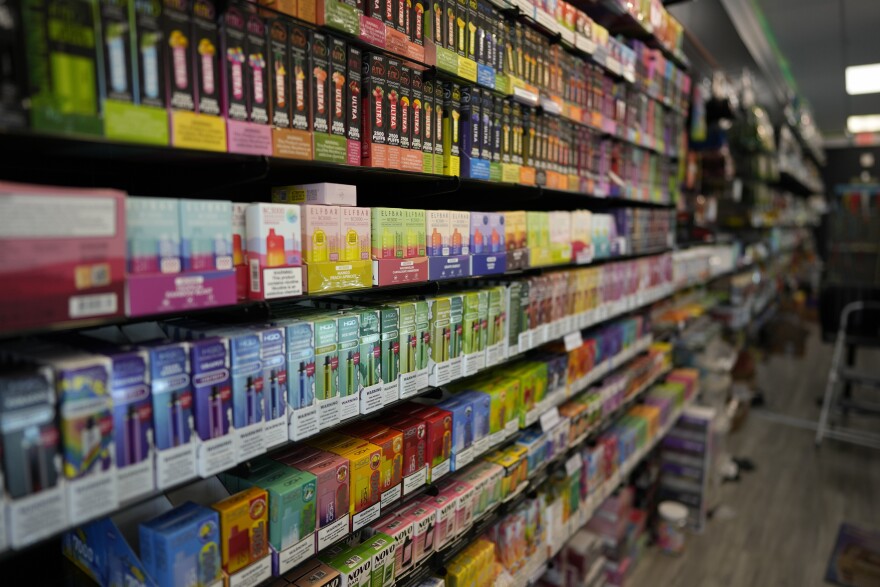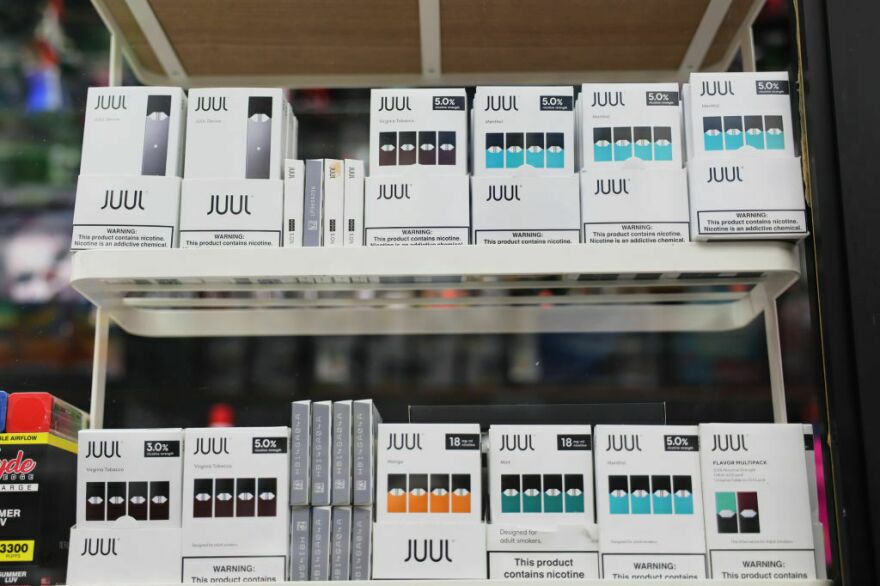G Kumar's vaping addiction peaked in college at the University of Colorado, when flavored, disposable vapes were taking off.
The disposables would have more than a thousand puffs in them. "I'd go through, let's say, 1,200 puffs in a week," said Kumar, who uses they/them pronouns.
Vaping became a crutch. Like losing a cell phone, losing a vape pen would set off a mad scramble. "It needs to be right next to my head when I fall asleep at night and then in the morning I have to thrash through the sheets and pick it up and find it," Kumar recalled.
They got sick often, including catching COVID — and vaping through all of it.
Kumar, now 24, did end up quitting. But many of their generation can't shake the habit.
"Everyone knows it's not good for you and everyone wants to stop," said CU senior Jacob Garza who works to raise awareness about substance use as part of the school's Health Promotion program.
"But at this point, doing it all these years ... it's just second nature now," he said. "They're hooked on it."
For years, slick marketing by e-cigarette companies, and the allure of sweet, fruity or even candy-like flavors and names, led teens to try vaping. As more high schoolers and even younger kids picked up the behavior, doctors and researchers warned it could lead to widespread addiction, creating a 'Generation Vape.'
Now, new data about substance use among young adults suggests that many of those former teen vapers haven't quit.
Vaping use drops among teens, rises among young adults
In Colorado, the share of those aged 18 to 24 who regularly vaped rose by about 61% from 2020 to 2022 – to nearly a quarter of that age group.
"That's an astounding increase in just two years," says Dr. Delaney Ruston, a primary care physician and documentary filmmaker.
Nationally, vaping rates for young adults increased from 7.6% in 2018 to 11% in 2021.

Research has shown nicotine is highly rewarding to the brains of young people.
"It's not surprising that many of them start in high school for social reasons, for all sorts of reasons," says Ruston, whose latest film is Screenagers Under the Influence: Addressing Vaping, Drugs, and Alcohol in the Digital Age. "And many of them now — we're seeing this — have continued to college and beyond."
Meanwhile, vape rates have actually dropped among Colorado high schoolers, said Tiffany Schommer, the tobacco cessation supervisor with Colorado's state health department.
At one point, before the pandemic, Colorado led the nation in youth vaping, topping 37 states surveyed for use of electronic cigarettes among high school students.
Vaping peaked among minors in Colorado in 2017 with 27% of Colorado youth reporting they had vaped in the past month, according to the Healthy Kids Colorado Survey. But by 2021, the most recent year for which there's data, that dropped to 16%.
Nationally vaping rates among high schoolers dropped from 28% in 2019 to 12.6% in 2023, according to the Annual National Youth Tobacco Survey.
But for many young people who started vaping at the height of the trend, a habit was set.
"E-cigarette use has increased, particularly among people who have never smoked [traditional cigarettes,]" said Schommer. "So these are folks who started with vapes, continue with vapes."
Preliminary data indicates that almost half of those vaping 18- to 24-year-olds started vaping before they turned 18, according to the Colorado 2022 Tobacco Attitudes and Behaviors Survey.
'They weren't able to stop.'
At Children's Hospital Colorado, pediatric pulmonologist Dr. Heather De Keyser pulls up on her screen a clouded X-ray of the lung of a young adult damaged by vaping.
"This is a patient with vaping-related lung injury," she says.
For years, doctors like her and public health experts wondered about the potential harmful impact of vaping on pre-adult bodies and brains — especially the big risk of addiction

"I think, unfortunately those lessons that we were worried we were going to be learning, we're learning. The data is bearing out in that," said De Keyser, an associate professor of pediatrics in the Breathing Institute at Children's Hospital Colorado. "We're seeing increases in those young adults. They weren't able to stop."
It's no coincidence the vaping rates soared during the pandemic, according to several public health experts.
For the past couple of years, undergraduates have talked about the challenges of isolation and using more substances, said Alyssa Wright, Early Intervention program manager at Health Promotion at CU Boulder.
"Just being home, being bored, being a little bit anxious, not knowing what's happening in the world," Wright said. "We don't have that social connection, and it feels like people are still even trying to catch up from that experience."
Other factors driving addiction are the high nicotine levels in vaping devices, and "stealth culture," says Chris Lord, CU Boulder's associate director of the Collegiate Recovery Center.
"The products they were using had five times more nicotine than previous vapes had," he says. "So getting hooked on that was ... almost impossible to avoid."
As far as "stealth culture," Lord means that vaping is exciting, something forbidden and secret. "I think as an adolescent, our brains are kind of wired that way, a lot of us," Lord said.
The Juul effect
Wind the clock back half a decade and one could see the seeds of these current vaping rates.
In 2019, if you typed the word "Juul" into the search bar on YouTube, you could find an endless stream of videos of young people showing off how cool it was to use the company's sleek, high-tech-looking vaping device.

In one video Colorado Public Radio found in 2019, two young women show how they "make parties more fun."
"We just chillin',' one says, laughing. "We vapin' and we Juul-in'."
Many of those videos are no longer available, pulled off the platform once the trend took off. Searching for Juul now brings up many videos warning of the dangers and how to talk to kids.
All over the U.S., state and local governments, including Colorado, filed suit, alleging Juul Labs misrepresented the health risks of its products.
Juul agreed to pay hundreds of millions in settlements, including a nearly $32 million settlement last year with Colorado.
Juul had become No. 1, the top e-cigarette company, the lawsuits argued, by first aggressively marketing directly to kids, who then spread the word themselves by posting to social media sites like YouTube, Instagram and TikTok.
"What vaping has done, getting high schoolers, in some cases even middle schoolers, hooked on vaping, is now playing out," says Colorado attorney general Phil Weiser, a parent of two teens himself. He said vape companies followed the tobacco industry playbook — with a similar impact on young consumers. "They're still hooked. This is a very addictive product."
Juul did not respond to requests for comment.
R.J. Reynolds, which makes another popular brand, Vuse, sent NPR this statement: "We steer clear of youth enticing flavors, such as bubble gum and cotton candy, providing a stark juxtaposition to illicit disposable vapor products."
Other big vape companies, like Esco Bar, Elf Bar, Breeze Smoke and Puff Bar didn't respond to requests for comment.
"If we lived in an ideal world, adults would reach the age of 24 without ever having experimented with adult substances. In reality, young adults experiment," said Greg Conley, director of legislative & external affairs with American Vapor Manufacturers. "This predates the advent of nicotine vaping."
The FDA banned flavored vape cartridges in 2020 in an effort to crack down on marketing to minors, but the products are still easy to find.
Debate over vaping's role in smoking cessation
One claim often made in defense of vaping is that it can help users quit cigarette smoking.
Joe Miklosi, a consultant to the Rocky Mountain Smoke-Free Alliance, a trade group for vape shops contends the shops are not driving vaping rates among young adults in Colorado.
"We keep demographic data in our 125 stores. Our average age (of customers) is 42," he says.
Vape shops sell products to help adult smokers quit, Miklosi says, with lower levels of nicotine than big companies like Juul. Miklosi claims he's talked to thousands of consumers who claimed vaping helped them quit smoking cigarettes.
But the Colorado data belies that, according to longtime tobacco researcher Stanton Glantz.
The 18-24 age group leads all age groups in regular use, and use gradually dropped with each age cohort, up to the 65+ demographic, of which just 1% use e-cigarettes.
The data are "completely inconsistent with the argument that most e-cigarette use is adult smokers trying to use them to quit," said Glantz, the now-retired director of the Center for Tobacco Control Research and Education at the University of California San Francisco.
Glantz says because of the onslaught of sleek technology, flavors, and marketing used by Juul and other companies "the kids are getting addicted younger and faster," compared to earlier decades when traditional cigarettes dominated the tobacco market.
Finding the will to quit
For recent college graduate G Kumar, now a rock climber, the impetus to quit vaping was more ecological than health-related. It was "knowing the amount of trash [from used up vape devices] that I was accumulating and the amount of money I was spending," they said.
Kumar got some help from a package of cessation literature and quitting aids from CU's Health Promotion program. It included two boxes of eucalyptus-flavored toothpicks, which tasted awful to Kumar, but provided a distraction and helped with oral cravings.
"The fact that I could just gnaw on toothpicks for weeks on end was, I think, what kept me sane," Kumar said.
It took a while and a lot of willpower to overcome the intense psychological craving, something many others in that generation know all too well.
This story was produced in partnership with CPR News and KFF Health News.
Copyright 2024 CPR News

